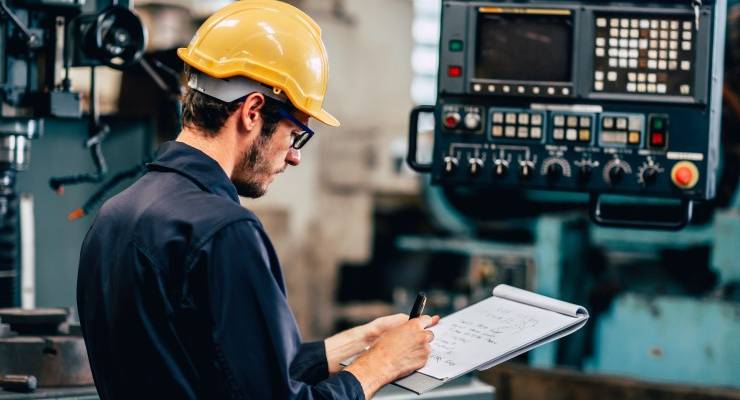
If your business is building sets and stages for outdoor events, what do you do when suddenly all events are cancelled because of COVID-19?
If you are the Australian manufacturer Stagekings, you get advice from a mate in Ireland and start building desks instead.
Nick Martin from Stagekings says since the company turned to manufacturing working-from-home desks its full-time staff has grown from pre-COVID-19 numbers. Today it employs 52 people: about 20 in its Kurnell warehouse and others working from home or doing deliveries.
The company’s product line has expanded from desks to stand-up desks, monitor and laptop stands, wine racks and stools. A popular line is small but elegant desks for the newly created market of kids’ home-schooling.
The firm takes 120 to 150 orders a day in Australia, and with inquiries coming from New Zealand, Singapore and the United States, it might soon become an exporter.
It is just one example of what can be a positive from the pandemic: a revival in Australian manufacturing. Changing the way we work, learn and play creates opportunities for domestic manufacturers.
Some firms have expanded for obvious reasons. Sydney’s Resmed manufactures ventilators, among other products. In response to COVID-19 it is looking at “double or triple” output.
Ventilators are in high demand. Australia is relatively well supplied, not only because they are manufactured locally but also because the virus has been reasonably successfully contained so far. However, demand from other countries makes this a good export prospect.
There’s also a huge new market in personal protective equipment including masks and hand sanitiser. Not only are skincare companies ramping up production, but also new and unlikely manufacturers of hand sanitiser have emerged: distillers, the Corowa chocolate factory, the stationery company Karst. Shortages reported on by Crikey in March are less of a worry today.
The COVID-19 Co-ordination Commission has asked former Dow Chemicals chief executive Andrew Liveris to “identify opportunities for growth in manufacturing once Australia moves into the recovery stage”.
We don’t know when recovery will start but we don’t need to wait. Manufacturing opportunities are arising already, catering not only to those working from home, but in fields such as food, transport and energy.
We face two distinct paths with manufacturing policy: one looks backwards to past glories, the other forward.
There is still a push to bring back an Australian vehicle manufacturing industry. When US President Donald Trump ordered General Motors to manufacture ventilators, the Society of Automotive Engineers called for Australia to rebuild its car industry. It is not necessary — other manufacturers can do ventilators.
A car industry is last century’s factories building a product invented the century before. It requires a scale that the Australian domestic market cannot support and a commitment to old technology. There are better niches for manufacturing.
An opportunity will arise from a need to rethink large government projects such as submarines as money becomes tight after the huge COVID-19 spend. Are traditional submarines a good investment when a generation of autonomous underwater vessels is starting up? Can Australian defence be smarter in purchasing Australian technology?
We have defence suppliers that are already world leaders. More can emerge if we think about future preparedness rather than fighting the last war.
That points to a way forward for policy. Old school protectionism will fail. All that Australia’s high levels of protection in the 1950s and ’60s did was help a few companies while making consumers worse off. Winding them back raised Australian living standards (noting there is less evidence for benefits from reducing low tariffs still further).
The same applies to subsidies. They almost always degenerate into windfall payments to a few wealthy and well-connected mates (for an incisive analysis see Game of Mates by Cameron Murray and Paul Frijters).
Grants to particular companies — especially if there is ministerial discretion — will more likely than not be misused or misapplied. Non-discriminatory policy for all manufacturers is better.
Useful roles for government include:
- Partnering with manufacturers in industries dominated by government — such as health and defence — and paying more for quality, security and reliability
- Helping manufacturers to navigate export rules, needed even more in a post-COVID-19 world when different countries will have idiosyncratic controls
- Linking manufacturing with research — for example, through Australian Research Council linkage grants or the National Collaborative Research Infrastructure scheme
- Continuing tax incentives for innovation
- Regulating unfair competition to ensure big corporations are unable to crush innovation from medium-sized companies such as Stagekings.
Professor Roy Green observed in relation to the closure of Holden that the problem was not using public funds to support manufacturing, but using them to prioritise what worked in the past rather than for the future. Its a common failing with manufacturing policy. The Covid-19 crisis offers an alternative pathway.
Because of its unprecedented impact it is of necessity driving alternative thinking in manufacturing. Our choice is whether to foster new entrants and reimagined firms, or throw money at old established firms. If governments chooses the latter, workforce and investors will follow. Innovators will be left behind, leaving us to look back in a decade and mark another opportunity missed. We can only hope the government and its advisers choose the first path.








Crikey is committed to hosting lively discussions. Help us keep the conversation useful, interesting and welcoming. We aim to publish comments quickly in the interest of promoting robust conversation, but we’re a small team and we deploy filters to protect against legal risk. Occasionally your comment may be held up while we review, but we’re working as fast as we can to keep the conversation rolling.
The Crikey comment section is members-only content. Please subscribe to leave a comment.
The Crikey comment section is members-only content. Please login to leave a comment.